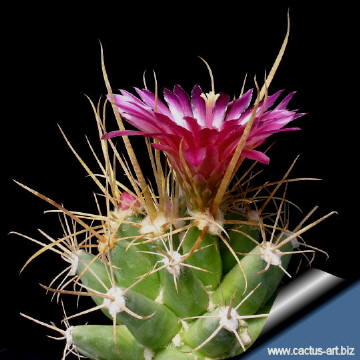CACTACEAE
Cactus family
Cactaceae includes approximately 93 genera of succlent herbs, shrubs, and trees from the Americas, with greatest diversity in mild temperate semiarid regions of North America. Some tropical species are climbers and epiphytes. One non – American species, Rhipsa -lip baccifera, comes from western Africa. Stems are usually thickened, succulent water – storing adapta-tions to arid climates. They may be flattened and jointed or cylindrical and deeply ridged. Spines and barbed hairs (glochids) are on raised pads, Which are actually rudimentary branch tips. Cacti are distinguished from other desert species by the spines clus- tered in areoles, not evenly distributed, and by the clear not milky sap. Leaves are usually absent, or reduced and ephemeral, with the exception of Pereskia species, Which have well – developed, persistent simple leaves. Flowers are usually bisexual and solitary with numerous tepals. The fleshy fruits of cer-tain cacti are edible and tasty, with an appearance somewhat like kiwi fruits when cut. Nopales, stem seg-ments of Opuntia species, are eaten as a vegetable in Mexico after spines are removed. They are also fed to animals. Certain birds and other animals have developed sym-biotic ralationships with cactus species. Hummingbirds are at-tracted to the flowers.
No fomal name exists for this com-plex group of intergeneric hybrids of garden origin commonly referred to as orchid cacti, a name also ap-plied to Epiphyllum species. The hy-brids are commonly, though incor-rectly, listed as Epiphyllum cultivars, even though they usually involve Disocactus, Heliocereus, Schlumber-gera, or Selenicereus , but rarely Epiphyllum species (Anderson 2001). Flowers are large, goblet- shaped, and white or brightly colored. Most are day – bloomers. The clambering, spined stems are succulent, flat- tened, cylindrical or angular de- pending on heredity. They are easy to grow, needing only some protec – tion from harsh midday sun and cold. They thrive in a coarse bark mix in dry climates like California but are grown without medium in humid climates. Plants become heavy and should be attached to a sturdy basket or tree limb.
Cactus hybrids

Orchid – cactus
Garden origin, Succulent epi- phytes, zones 9-11. Bloom inter- mittenly in warm months. Regular moisture.
In bark orchid medium of free – growing. Bright filtered light to part sum. Flowers: goblet – shaped, to 8 in. wide, tepals white or brightly colored, solitary. Leaf-less. Stems: flattened or cylindtical, more or less spiny. Easily propa- gated from cuttings. Larger cuttings start to bloom sooner.


Deprecated: strpos(): Passing null to parameter #1 ($haystack) of type string is deprecated in /home/agriviek8Qv/agriviet.net/public_html/wp-includes/comment-template.php on line 2522